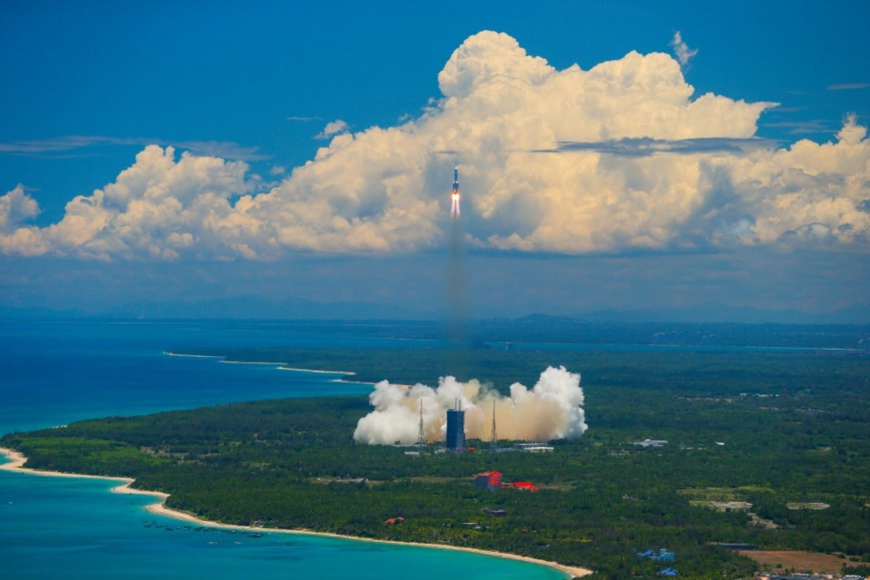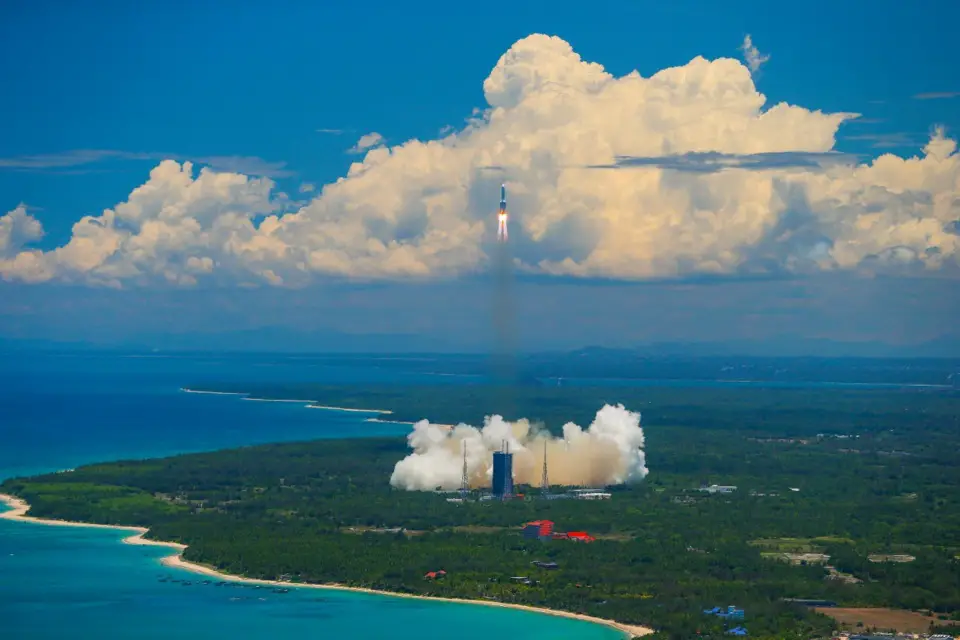By Wen Wu, People's Daily

China's Long March-5 Y4 carrier rocket launches the country's first Mars exploration mission Tianwen-1 at the Wenchang Spacecraft Launch Site in south China's Hainan on July 23. (By Zhang Mao/People's Daily Online)
China launched its first Mars exploration mission Tianwen-1 on July 23 with the fourth Long March-5 rocket coded as Long March-5 Y4 at the Wenchang Spacecraft Launch Site in south China's Hainan province.
The Mars probe is expected to take about seven months to reach the planned orbit around Mars, after which it will carry out tasks of orbiting, landing and roving in one mission.
On July 27, with its optical navigation instruments, the probe captured an image of the Earth and Moon from some 1.2 million kilometers away from Earth.
China has made a lot of preparations for the mission. The Beijing Aerospace Flight Control Center has carried out repeated drills for various systems to support the launch, while the Xi'an Satellite Control Center in northwest China's Shaanxi province has improved the adaptability of the space-ground communication system for the mission.
Deep-space ground control stations in Kashgar, northwest China’s Xinjiang Uygur Autonomous Region, and Jiamusi, northeast China's Heilongjiang province, had been well-prepared to provide support in measurement and control before the launch.
Meanwhile, two Tianlian satellites, China's tracking and data relay satellite series, had constantly sent telemetry data back to the ground from the geosynchronous orbit.
The reason why China chose to launch its Tianwen-1 probe to Mars at this time of the year is to take advantage of the Hohmann transfer orbit, which is considered the best route from Earth to Mars.
Proposed in the 1920s by German engineer Walter Hohmann, the Hohmann transfer orbit forms every 26 months and falls in the summer this year.
What’s the most difficult part of the Mars mission?
To escape Earth's gravitational field and fly to Mars, an object has to reach the "second cosmic velocity" of about 11.2 kilometers per second. The greater the mass of the object is, the more difficult it is for the object to attain the speed.
The Tianwen-1 probe, however, weighs about five tonnes, making it the heaviest deep-space probe ever launched by China.
This mission marks the first time that Long March-5 carrier rocket exceeds the second cosmic velocity, the fastest China's carrier rockets have gone to date.
Another problem for the mission lay in the information transmission. The fastest speed at which human beings can transmit information is the speed of light, which is 300,000 kilometers per second.
However, the distance between Mars and the Earth exceeds 50 million kilometers at the closest and reaches 400 million kilometers at the farthest, which results in an information transfer delay ranging from several minutes to dozens of minutes.
The delay in information transmission means the Tianwen-1 probe can't be directly controlled by the control center on Earth and needs to deal with the unknown environment in the deep space by itself and make judgments and choices on its own.
What’s the purpose of the Mars mission?
The purpose of the Mars mission is not just reaching Mars, as the real goal is to collect as much effective scientific data as possible, according to Liu Tongjie, spokesperson for China’s Mars probe mission as well as deputy head of the Lunar Exploration and Space Engineering Center under the China National Space Administration (CNSA).
The orbiter is equipped with seven instruments and the rover set up with six payloads, Liu added.
After it landed on Mars, the Tianwen-1 probe will send back images of Mars, investigate the surface and geological structure of the planet, measure and record the climate and magnetic fields, and collect a large amount of scientific data.
Why Mars?
Mars has similar natural environment with Earth and has always been a priority target for manned deep-space exploration outside the Earth-Moon system, Liu pointed out.
In previous explorations, human beings have found evidence that suggests the existence of water on Mars.
Since then, whether Mars is hospitable to life and whether it has connections with Earth have become major scientific issues of the research on Mars. The study of Mars is believed to be significant for understanding the evolution of the Earth.
Tianwen-1, meaning Questions to Heaven, comes from a poem by Qu Yuan (about 340-278 BC), one of the greatest poets of ancient China.
Although about 2,300 years have passed, human beings nowadays still have many questions about the outer space.
Representing a starting point of the planetary exploration program in China's aerospace cause, the Mars mission symbolizes China's pursuit of and progress in exploring the deeper space.
So far, China has established space stations hundreds of kilometers away from the ground, sent spacecrafts to the Moon that is 300,000 kilometers away from the Earth, and started to explore Mars in the deeper space.
Step by step, China is marching toward farther places in the universe with the exploration spirit and persistent efforts of Chinese astronauts.
The Mars probe is expected to take about seven months to reach the planned orbit around Mars, after which it will carry out tasks of orbiting, landing and roving in one mission.
On July 27, with its optical navigation instruments, the probe captured an image of the Earth and Moon from some 1.2 million kilometers away from Earth.
China has made a lot of preparations for the mission. The Beijing Aerospace Flight Control Center has carried out repeated drills for various systems to support the launch, while the Xi'an Satellite Control Center in northwest China's Shaanxi province has improved the adaptability of the space-ground communication system for the mission.
Deep-space ground control stations in Kashgar, northwest China’s Xinjiang Uygur Autonomous Region, and Jiamusi, northeast China's Heilongjiang province, had been well-prepared to provide support in measurement and control before the launch.
Meanwhile, two Tianlian satellites, China's tracking and data relay satellite series, had constantly sent telemetry data back to the ground from the geosynchronous orbit.
The reason why China chose to launch its Tianwen-1 probe to Mars at this time of the year is to take advantage of the Hohmann transfer orbit, which is considered the best route from Earth to Mars.
Proposed in the 1920s by German engineer Walter Hohmann, the Hohmann transfer orbit forms every 26 months and falls in the summer this year.
What’s the most difficult part of the Mars mission?
To escape Earth's gravitational field and fly to Mars, an object has to reach the "second cosmic velocity" of about 11.2 kilometers per second. The greater the mass of the object is, the more difficult it is for the object to attain the speed.
The Tianwen-1 probe, however, weighs about five tonnes, making it the heaviest deep-space probe ever launched by China.
This mission marks the first time that Long March-5 carrier rocket exceeds the second cosmic velocity, the fastest China's carrier rockets have gone to date.
Another problem for the mission lay in the information transmission. The fastest speed at which human beings can transmit information is the speed of light, which is 300,000 kilometers per second.
However, the distance between Mars and the Earth exceeds 50 million kilometers at the closest and reaches 400 million kilometers at the farthest, which results in an information transfer delay ranging from several minutes to dozens of minutes.
The delay in information transmission means the Tianwen-1 probe can't be directly controlled by the control center on Earth and needs to deal with the unknown environment in the deep space by itself and make judgments and choices on its own.
What’s the purpose of the Mars mission?
The purpose of the Mars mission is not just reaching Mars, as the real goal is to collect as much effective scientific data as possible, according to Liu Tongjie, spokesperson for China’s Mars probe mission as well as deputy head of the Lunar Exploration and Space Engineering Center under the China National Space Administration (CNSA).
The orbiter is equipped with seven instruments and the rover set up with six payloads, Liu added.
After it landed on Mars, the Tianwen-1 probe will send back images of Mars, investigate the surface and geological structure of the planet, measure and record the climate and magnetic fields, and collect a large amount of scientific data.
Why Mars?
Mars has similar natural environment with Earth and has always been a priority target for manned deep-space exploration outside the Earth-Moon system, Liu pointed out.
In previous explorations, human beings have found evidence that suggests the existence of water on Mars.
Since then, whether Mars is hospitable to life and whether it has connections with Earth have become major scientific issues of the research on Mars. The study of Mars is believed to be significant for understanding the evolution of the Earth.
Tianwen-1, meaning Questions to Heaven, comes from a poem by Qu Yuan (about 340-278 BC), one of the greatest poets of ancient China.
Although about 2,300 years have passed, human beings nowadays still have many questions about the outer space.
Representing a starting point of the planetary exploration program in China's aerospace cause, the Mars mission symbolizes China's pursuit of and progress in exploring the deeper space.
So far, China has established space stations hundreds of kilometers away from the ground, sent spacecrafts to the Moon that is 300,000 kilometers away from the Earth, and started to explore Mars in the deeper space.
Step by step, China is marching toward farther places in the universe with the exploration spirit and persistent efforts of Chinese astronauts.
 Menu
Menu
 China’s successful launch of Tianwen-1 Mars mission marks steady progress in exploring the outer space
China’s successful launch of Tianwen-1 Mars mission marks steady progress in exploring the outer space
















